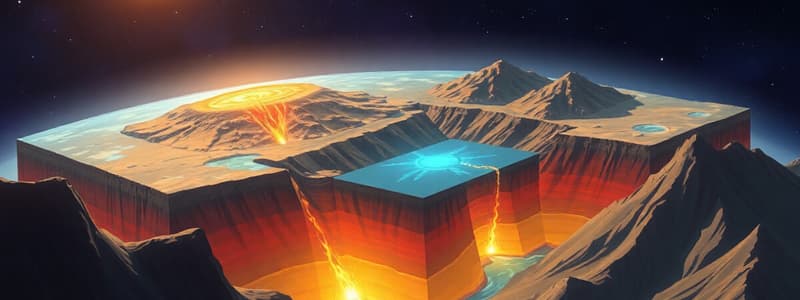Podcast
Questions and Answers
What is the primary driving force behind plate tectonics?
What is the primary driving force behind plate tectonics?
- Convection currents in the Earth's mantle (correct)
- Earth's rotation
- Gravitational pull from the moon
- Earth's magnetic field
Which type of plate boundary is characterized by plates moving apart from each other?
Which type of plate boundary is characterized by plates moving apart from each other?
- Convergent boundary
- Transform boundary
- Destructive boundary
- Divergent boundary (correct)
Which mineral is primarily composed of calcium carbonate?
Which mineral is primarily composed of calcium carbonate?
- Quartz
- Gypsum
- Dolomite
- Calcite (correct)
What process leads to the creation of new oceanic crust?
What process leads to the creation of new oceanic crust?
Which term describes the preservation of an organism’s structure within rock?
Which term describes the preservation of an organism’s structure within rock?
Which of the following is an example of a sedimentary rock?
Which of the following is an example of a sedimentary rock?
What type of energy resource derives from the remains of ancient plants and animals?
What type of energy resource derives from the remains of ancient plants and animals?
What term refers to the pieces of the Earth's lithosphere that move over the semi-solid mantle?
What term refers to the pieces of the Earth's lithosphere that move over the semi-solid mantle?
Which fossil fuel is known to produce the least pollution when burned?
Which fossil fuel is known to produce the least pollution when burned?
What is the process called that involves the preservation of organism structures through mineralization?
What is the process called that involves the preservation of organism structures through mineralization?
Which term refers to the circular movements of hot magma that drive plate tectonics?
Which term refers to the circular movements of hot magma that drive plate tectonics?
What geological feature is formed by the divergence of tectonic plates?
What geological feature is formed by the divergence of tectonic plates?
What describes the formation of new oceanic crust at divergent boundaries?
What describes the formation of new oceanic crust at divergent boundaries?
Which of the following is NOT considered a fossil fuel?
Which of the following is NOT considered a fossil fuel?
Flashcards
What drives plate tectonics?
What drives plate tectonics?
The process where magma rises, cools, and sinks, causing the Earth's crust to move in plates.
Divergent Boundary
Divergent Boundary
A boundary where tectonic plates move apart, creating new crust.
Calcite
Calcite
A mineral primarily composed of calcium carbonate (CaCO₃), often found in limestone and marble.
Solar Energy
Solar Energy
Signup and view all the flashcards
Fossil Fuels
Fossil Fuels
Signup and view all the flashcards
Permineralization
Permineralization
Signup and view all the flashcards
Sea-floor Spreading
Sea-floor Spreading
Signup and view all the flashcards
Limestone
Limestone
Signup and view all the flashcards
Convection Currents
Convection Currents
Signup and view all the flashcards
Tectonic Plates
Tectonic Plates
Signup and view all the flashcards
Natural Gas
Natural Gas
Signup and view all the flashcards
Study Notes
Plate Tectonics
- Plate tectonics are driven by convection currents in the Earth's mantle.
- Hot magma rises, cools, and sinks, moving the plates.
- Earth's rotation is not the primary driving force.
Plate Boundaries
- Divergent boundaries: Plates move apart, creating new crust (e.g., mid-ocean ridges).
- Convergent boundaries: Plates collide, often forming mountains.
- Transform boundaries: Plates slide past each other (e.g., San Andreas Fault).
Minerals
- Calcite is a mineral composed of calcium carbonate (CaCO₃).
- It's a key component of limestone and marble.
Energy Resources
- Solar energy converts sunlight into electricity.
- Fossil fuels (coal, oil, natural gas) are formed from ancient plant and animal remains.
- Natural gas is the cleanest-burning fossil fuel.
Geological Processes
- Permineralization: Minerals replace organism structures, preserving them in rock.
- Sea-floor spreading: New oceanic crust forms at divergent boundaries as magma rises.
- Limestone is a sedimentary rock formed from compacted sediments (including shell fragments and calcium carbonate).
- The Earth's lithosphere is divided into tectonic plates.
Studying That Suits You
Use AI to generate personalized quizzes and flashcards to suit your learning preferences.




